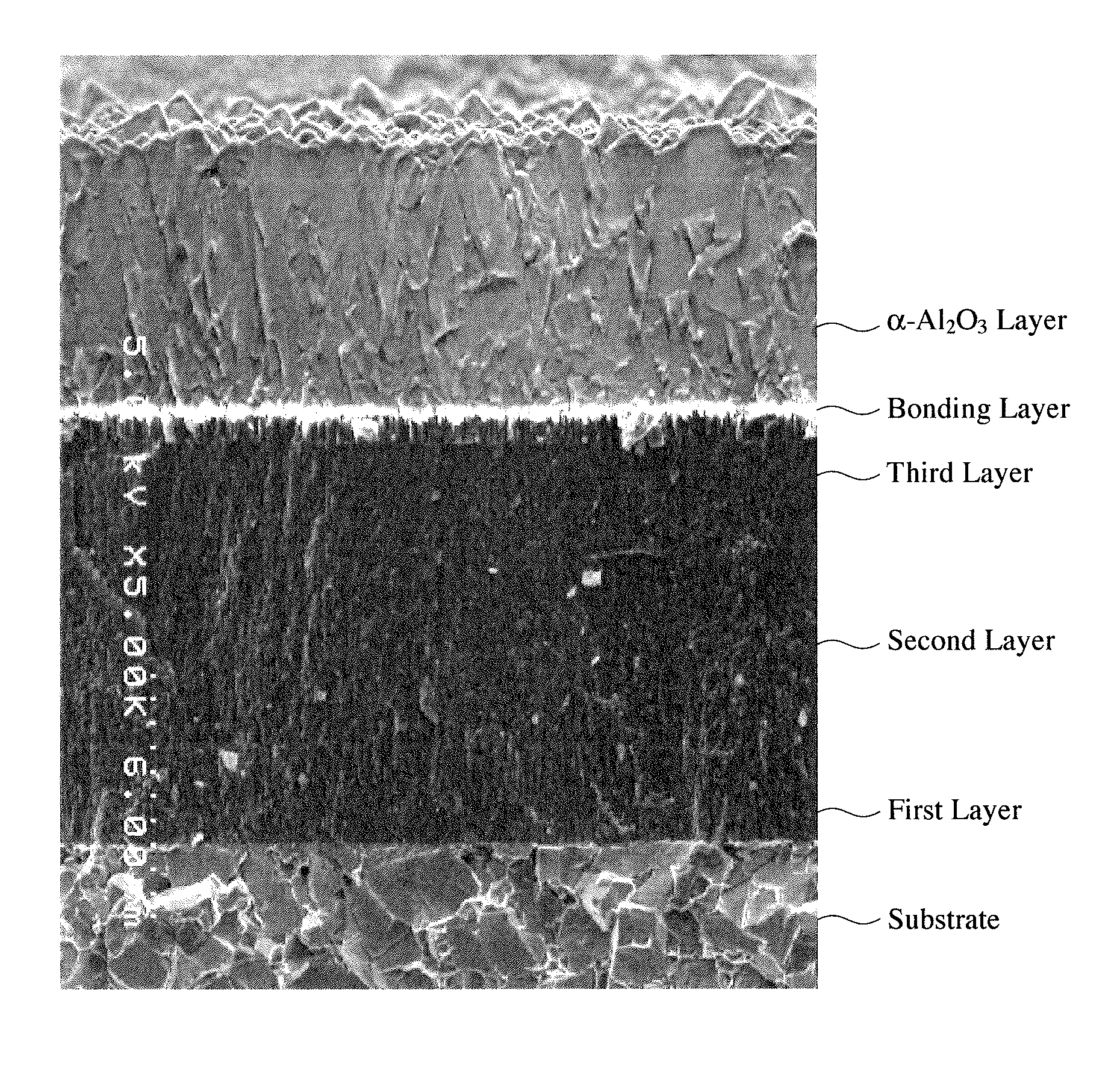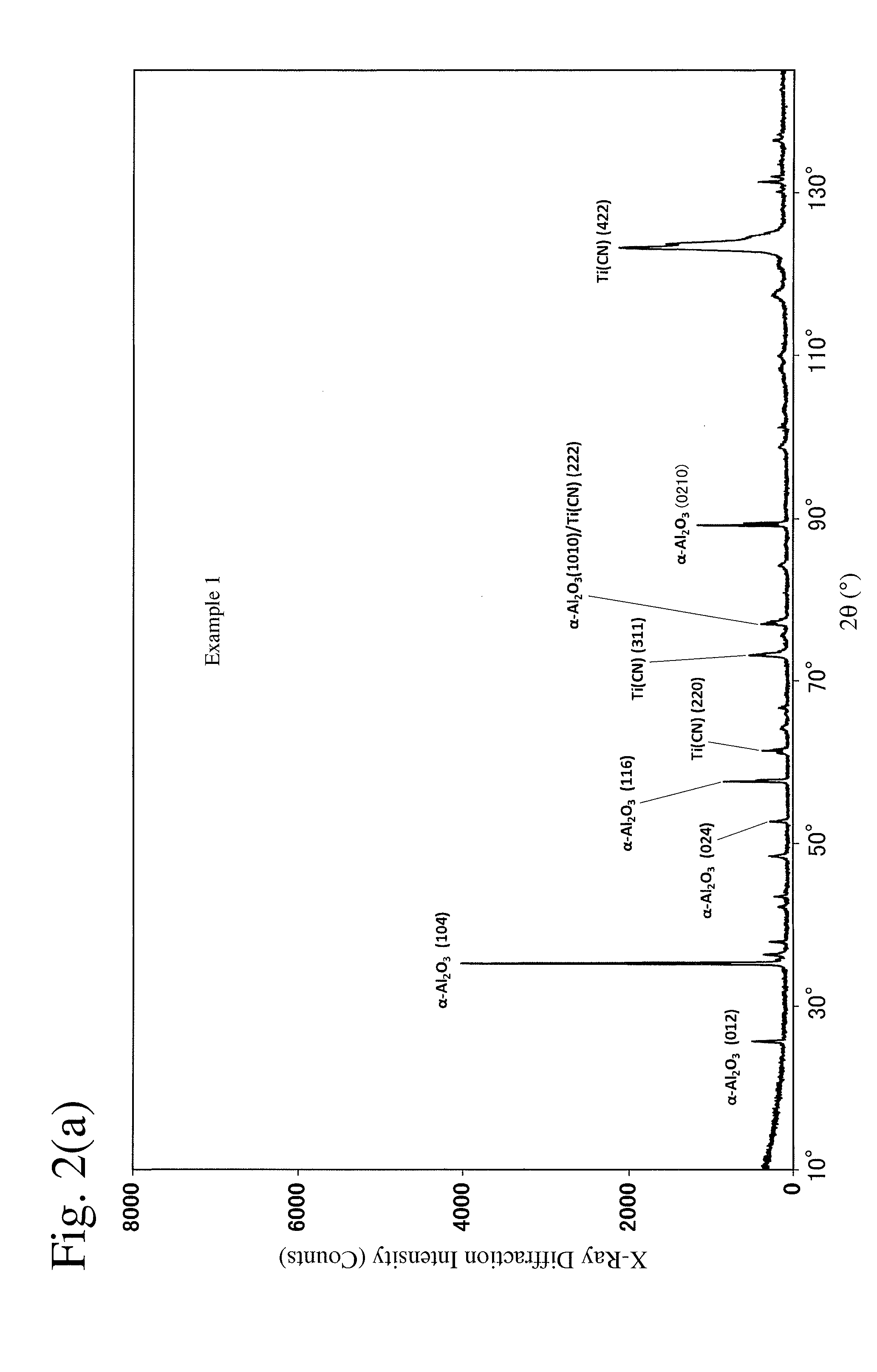Hard-coated member and its production method, and indexable rotary tool comprising it
a technology of hard coating and rotary tool, which is applied in the direction of manufacturing tools, superimposed coating process, transportation and packaging, etc., can solve the problems of insufficient adhesion of aluminum oxide film, insufficient adhesion of upper titanium carbonitride layer, and failure to have sufficient adhesion, etc., to achieve high hardness and wear resistance, and high adhesion
- Summary
- Abstract
- Description
- Claims
- Application Information
AI Technical Summary
Benefits of technology
Problems solved by technology
Method used
Image
Examples
example 1
[0141](1) Formation of Hard Coating Comprising Titanium Carbonitride Layer, Bonding Layer and Oxide Layer
[0142]Cutting edge portions 21 of a turning insert substrate (TNMG160408) 20 made of cemented carbide comprising 6% by mass of Co, the balance being WC and inevitable impurities, which is schematically shown in FIGS. 3(a)-3(c), were honed by a diamond brush. Incidentally, 23 represents a land, and 24 represents a flank.
[0143]With this insert substrate (TNMG160408) disposed in a CVD chamber, the temperature in the CVD chamber was elevated to 850° C. while flowing an H2 gas. First, with a starting material gas at 850° C. and 10 kPa, which comprised 66.0% by volume of an H2 gas, 32.2% by volume of an N2 gas, 0.5% by volume of a TiCl4 gas, and 1.3% by volume of a C2H6 gas, supplied to the CVD chamber at a flow rate of 6100 ml / minute, a 0.5-μm-thick first layer was formed as a titanium carbonitride layer by a chemical vapor deposition method. With a starting material gas at 850° C. an...
examples 2-31
[0166]The titanium carbonitride layers, bonding layers and oxide layers of Examples 2-31 were formed in the same manner as in Example 1, except for changing the film-forming conditions of the first to third layers and the compositions of the bonding layers as shown in Tables 1-4, and their properties and performance were evaluated in the same manner as in Example 1. The concentration distributions of C and N in a thickness direction in the titanium carbonitride layer (first to third layers) of Example 2 are shown in FIG. 7.
example 32
[0172]After the first layer in the titanium carbonitride layer was formed on the same substrate with honed cutting edges as in Example 1 under the conditions shown in Table 11, an 8-μm-thick second layer having a composition of (TiZr)(CN) was continuously formed by supplying a starting material gas at 850° C. and 10 kPa, which comprised 80.3% by volume of an H2 gas, 15.0% by volume of an N2 gas, 1.5% by volume of a TiCl4 gas, 1.0% by volume of a CH3CN gas, 1.2% by volume of a C2H6 gas, and 1.0% by volume of a ZrCl4 gas, at a flow rate of 6700 ml / minute to the CVD chamber. A 2-μm-thick third layer having a composition of (TiZr)(CN) was then continuously formed by supplying a starting material gas at 850° C. and 10 kPa, which comprised 82.0% by volume of an H2 gas, 15.0% by volume of an N2 gas, 1.5% by volume of a TiCl4 gas, 0.5% by volume of a CH3CN gas, and 1.0% by volume of a ZrCl4 gas, at a flow rate of 6600 ml / minute to the CVD chamber. A bonding layer and an α-aluminum oxide fil...
PUM
| Property | Measurement | Unit |
|---|---|---|
| cross section diameter | aaaaa | aaaaa |
| thickness | aaaaa | aaaaa |
| thickness | aaaaa | aaaaa |
Abstract
Description
Claims
Application Information
 Login to View More
Login to View More - R&D
- Intellectual Property
- Life Sciences
- Materials
- Tech Scout
- Unparalleled Data Quality
- Higher Quality Content
- 60% Fewer Hallucinations
Browse by: Latest US Patents, China's latest patents, Technical Efficacy Thesaurus, Application Domain, Technology Topic, Popular Technical Reports.
© 2025 PatSnap. All rights reserved.Legal|Privacy policy|Modern Slavery Act Transparency Statement|Sitemap|About US| Contact US: help@patsnap.com



